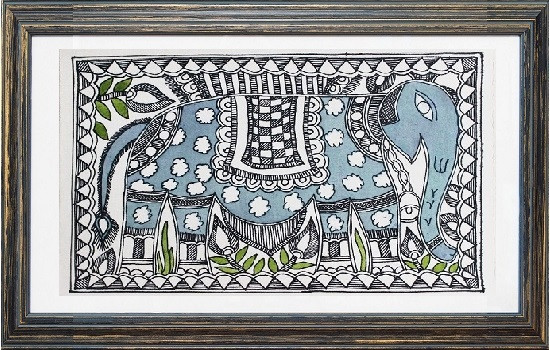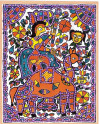[This piece of article is provided by Ms. SONAM DHINGRA who is a prominent art teacher at City Vocational Public School, Meerut, by profession and an artist herself. She has done in-depth research on indian arts and crafts.]
In the old times since women were not free to go outside their houses, it was their source of expression. These paintings were the medium for the women to highlight their feelings. Through their creativity they voiced their desires, hopes, dreams and expectations. Madhubani paintings imparted them the freedom of thoughts -a right they never had elsewhere. When any of the ladies painted the walls or floor, other ladies sang to help and support her, so this culture contains many forms of creativity (painting, writing, singing etc). However, in modern times, women used this skill
to fulfil their financial needs since they couldn’t go out for labour or any other work. This art acted as a messenger of God for many families and helped them to get through their bad times. For the Maithil artists, the ability to express their desires, dreams, expectations, hopes and aspirations to their community in (picture) writing through their painting was most likely much more valuable than communicating detailed information to outsiders by means of phonetic writing.
“Unlike words, depictions are full of meaning: they are always specific. So on the one hand there is a finite stock of words—vague, general, nearly empty of meaning; on the other hand there is a n infinitely large potential of depictions—precise, specific, and full of meaning” (Kress, 2005).
The meaning they conveyed through their art was unmistakable and accessible to all. In this case, picture writing literacy did not lead to phonetic or alphabetic writing literacy. It did, however, require education as all writing is communication technology, Maithil art required education to master the particular tools, materials and techniques of this unique style of picture writing. Most of these artists were not formally educated and were illiterate in the ways of phonetic reading and writing. But they did have to learn about the range of natural hues that could be derived from preparations and combinations of clay, bark, flowers and berries as well as how to fashion brushes from bamboo twigs and small pieces of cloth (Mishra, 2009).
Women were exceptionally literate in picture writing. As with oral communication, this type of literacy served to bring people together and strengthen their communities. Every visual text has a performative aspect, since a visual is meant to be displayed and it conveys a meaning because the audience views it. The paintings of Mithila are always made to be viewed by the community and have a distinct performative aspect. Even after the ritual need of the painting is over, it stays on till the next festive occasion when a fresh painting is made. The visuality of the painting communicates the idea to the idea to the audience and crystallises it in their minds. The narratives which are depicted in the paintings and the symbolic motifs which narrate the story, are shared within the as they circulate among the audience which views the paintings. The visual image acts as a vehicle for reinforcing the tradition within the community. Women act as the agency for this dissemination and reinforcement process, since they are usually the painters. The domestic space thus, acts as the perpetuator of the ritual.
Community follows a patriarchal system and the decision making space available to women is directly proportional to the social status and the economic prosperity of the family. This means that there are a few women who can have a strong say in the decision making process, but as we go down the social scale, this space becomes more and restricted. At the same time, there is a dominant discourse circulating in the community on the power of the Goddess and therefore, of the woman. In such a situation, women assert their power by articulating a distinct language of their own in the ritual arena of the domestic space. For, the domestic space traditionally belongs to them. This is perhaps an attempt to claim the space which is denied to them in the public sphere. Hence, the priestly rites have to converge with the rights of women, the Sanskrit chants have to coincide with the folk songs and the Brahmanical image has to coexist with the folk paintings.
This was art that gave a voice to powerless rural women as a communication technology. Nowadays men have also taken up this art form and paintings are done on paper, cloth, canvas etc. But even though women in the villages around Madhubani have been practicing their folk art for centuries, the world at large has come to know about these women and to consider them to be "artists" only in the last thirty years. Even now, most of their work remains anonymous. The women, some of them illiterate, are in any case reluctant to consider themselves individual producers of "works of art" and only a few of them mark the paintings with their own name.



